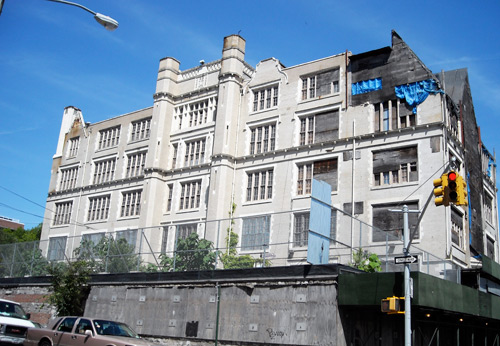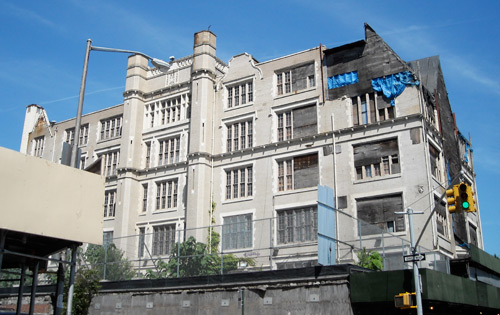Public School 31
The William Lloyd Garrison School
Between Grand Concourse and Walton Avenue, E.144th and E.146th Streets
C.B.J. Snyder
1899
At the turn of the twentieth century, “English Collegiate Gothic” seemed likely to become the only acceptable style for a serious American academic building. Not just anglophile Princeton and Yale, but the University of Chicago, and even New York’s free City College, were undertaking medievalization, in the Oxford-Cambridge manner, of their campuses. New York Board of Education architect C.B.J. Snyder saw to it that many of the city’s new public high schools followed the fashion— Erasmus Hall in Brooklyn, Curtis on Staten Island, and Morris High in the Bronx, whose immense crenellated tower can be seen over the rooftops from Hunt’s Point and still further east.
Just before building Morris, Snyder assayed the Oxbridge style at an elementary school erected a short distance to the south, in Mott Haven. PS 31—now the William Lloyd Garrison School—lacks the dramatic massing of the high school. Essentially a five-story rectangular box, its symmetrical facade has nevertheless been articulated with extreme clarity. Three bays stand on either side of a central tower that holds the arched entry—a ubiquitous Collegiate-style reference to a medieval gatehouse. Narrow octagonal piers run up alongside the tower, rising above its parapet in protruding turrets. The crisp skyline profile continues in the gables—two at the ends pointed, four between curved in the Elizabethan manner. Lower down, the facade is tied together horizontally by a thick limestone band at the third story, over which runs a molding strung with tiny grotesque medieval heads—for the school children who notice them, a small delight, one imagines, like their “castle” itself.
But what catch everyone’s eye at PS 31—as they catch the morning sun on the ridge-top building—are the 28 sets of windows banked on the faces of the bays and tower. Thick limestone mullions separate the tall, narrow lights, assembled in groups of five (or four on the tower). The mass of glazing is another allusion the Tudor university, where “Perpendicular”-style Gothic windows, with rectilinear rather than curving Continental tracery, provide veritable walls of glass. Historical reference, however, is not the whole explanation.
To understand, we need to glance back at Charles Snyder, a rare hero of bureaucratic architecture, and his Herculean task. When he was appointed Superintendent of School Buildings in 1891, New York (and the annexed districts of the Bronx) was caught in a towering wave of new immigration. Since 1880, the population had risen by a quarter, and would go up by another thirty-five percent in the next decade. The population of Mott Haven rose by 86 percent from 1892 to 1900 alone, with one third of the residents foreign born. For Snyder, who inherited a frighteningly inadequate set of schools, this meant a program of incessant building simply to provide at least a half-day’s education for most of the city’s children. While PS 31 was under construction, no fewer than twenty-one other Snyder schools were going up. Nevertheless, on the day it opened in 1899, the New York Times reported a “siege,” beginning at seven in the morning, of parents and children hoping to claim a desk.
A shortage of seats was not Snyder’s only problem. Urban school buildings, often crammed between tenements in mid-block locations, faced walls and depended on gaslights at midday. “[The] twilight gloom of one class-room,” an observer reported, “is such that the teacher cannot see the faces of her pupils.” Snyder took on the New York school as a special design challenge. Even as he accelerated construction with the use of steel frames, and bought up neighboring properties to free air space, he developed new building footprints—the H, the E, the I—which created courtyards outside the classrooms. Of particular concern were windows: “I believe that a schoolroom should be lighted from one single source of light stretching...from the rear to within 4 ft. or so of the front of the room at the left side of the pupils, and not by a series of windows alternating with brick and stone piers....”
So Snyder’s turn away from the arched Romanesque Revival style of his predecessor’s schools—which he himself had used in his first building, PS 67, the old High School of Performing Arts—was supremely functional. Over thirty-two years, he designed 140 elementary schools in a delightful variety of styles—Dutch Colonial, French Renaissance, and, eminently, Collegiate Gothic. And anyone who has ever attended a Snyder school will remember the classroom’s towering double-hung windows, requiring a long hooked pole and a self-important “window monitor.”
David Bady

